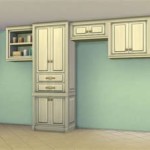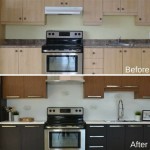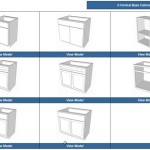How Kitchen Cabinets Should Be Organized
The kitchen serves as the heart of the home, a space where culinary creativity flourishes and families gather. An organized kitchen fosters efficiency and reduces stress, allowing individuals to locate necessary tools and ingredients swiftly. The organization of kitchen cabinets specifically contributes significantly to overall kitchen functionality. A well-structured cabinet system maximizes storage space, minimizes clutter, and enhances the aesthetic appeal of the kitchen environment.
Effective cabinet organization requires a strategic approach, considering individual needs, available space, and the frequency of item usage. Before undertaking the organizational process, it's crucial to assess the current state of the cabinets, identify areas for improvement, and plan the layout for optimal accessibility. This preliminary assessment serves as the foundation for a successful and sustainable organizational system.
De-Cluttering and Inventory Assessment
The initial step in organizing kitchen cabinets involves a thorough decluttering process. All items should be removed from the cabinets and placed on a countertop or table. This allows for a comprehensive assessment of existing contents. Begin by discarding expired food items, broken appliances, and duplicates of utensils or tools. Items that are rarely used or no longer needed should be donated or sold. This process immediately reduces the volume of items requiring storage and creates a clear space for efficient organization.
After decluttering, conduct an inventory of the remaining items. Categorize them according to type: cookware, bakeware, food storage containers, dry goods, spices, small appliances, and serving dishes. This categorization will guide the placement of items within the cabinets based on frequency of use and proximity to relevant work areas. The inventory should also identify any gaps in kitchen equipment that may need to be addressed, ensuring that the kitchen is adequately equipped for culinary tasks.
During the decluttering and inventory process, thoroughly clean the empty cabinets. Vacuum or wipe down the shelves and drawers to remove dust, crumbs, and spills. Consider lining the shelves with shelf liners to protect them from scratches and stains. This cleaning step provides a fresh start and contributes to the overall hygiene of the kitchen environment. Addressing cleanliness at this stage facilitates easier maintenance in the long run.
Strategic Placement and Accessibility
Following the decluttering and inventory assessment, the next step involves strategically placing items within the cabinets based on frequency of use and proximity to relevant work areas. Items used most frequently should be placed in easily accessible locations, while those used less often can be stored in higher or lower cabinets. Consider designating specific cabinets for specific categories of items to maintain order and consistency.
For example, cookware, such as pots and pans, should be stored near the stovetop for easy access during cooking. Bakeware, including baking sheets and cake pans, should be stored near the oven. Food storage containers should be kept together in a designated cabinet to facilitate quick retrieval and prevent clutter. Dry goods, such as flour, sugar, and pasta, should be stored in a cool, dry place away from direct sunlight. Spices are best organized in a spice rack or tiered shelf for easy identification and access.
Vertical storage solutions, such as pot lid organizers, plate racks, and tiered shelves, can maximize storage space within cabinets. These organizers allow for the vertical stacking of items, increasing the storage capacity of the cabinet and preventing items from being buried or lost. Adjustable shelves further enhance customization, allowing for the accommodation of items of varying heights. Properly utilizing vertical space significantly improves the overall efficiency of cabinet organization.
Consider the ergonomics of the kitchen when placing items. Heavy items should be stored in lower cabinets to minimize the risk of injury when lifting. Lighter items can be stored in higher cabinets. Avoid overcrowding cabinets, as this can make it difficult to locate items and increase the risk of items falling out. Leave sufficient space between items to allow for easy access and retrieval. Efficient ergonomics contribute to a safer and more comfortable kitchen environment.
Utilizing Organizational Tools and Accessories
A variety of organizational tools and accessories can enhance the functionality and efficiency of kitchen cabinets. These tools help to maximize space, prevent clutter, and improve accessibility. Investing in appropriate organizational tools can transform even the most disorganized cabinet into a well-structured storage space.
Spice racks are essential for organizing and displaying spices. They come in various forms, including tiered shelves, pull-out drawers, and magnetic strips. Spice racks allow for easy identification and access to spices, preventing them from being lost or buried in the back of the cabinet. Canisters and airtight containers are ideal for storing dry goods, such as flour, sugar, and pasta. These containers keep food fresh, prevent spills, and allow for easy monitoring of inventory levels. Lazy Susans can be used in corner cabinets to maximize space and improve accessibility. They allow for easy rotation of items, making it easier to reach items stored in the back of the cabinet.
Drawer dividers and organizers are essential for keeping drawers neat and organized. They prevent utensils and other items from becoming jumbled together, making it easier to locate specific items. Pot lid organizers are specifically designed to store pot lids neatly and efficiently. They can be mounted on cabinet doors or walls, freeing up valuable space within the cabinet. Under-shelf baskets can be attached to existing shelves to create additional storage space. They are ideal for storing lightweight items, such as dish towels, cleaning supplies, or small appliances.
Labeling is a crucial aspect of kitchen cabinet organization. Labeling shelves, drawers, and containers helps to identify the contents quickly and easily. Use clear, legible labels that are easy to read. This ensures that everyone in the household can easily find and return items to their designated locations, maintaining order and preventing clutter. Consistent labeling reinforces organizational habits and promotes a more efficient kitchen environment.
Selecting the appropriate organizational tools and accessories depends on individual needs and preferences. Consider the size of the cabinets, the type of items being stored, and the desired level of organization when choosing tools. Experiment with different organizational methods to find what works best. Regular maintenance and adjustments will ensure that the organization system remains effective over time.
In conclusion, organizing kitchen cabinets requires a systematic approach involving decluttering, strategic placement, and the utilization of organizational tools. By following these principles, individuals can transform their kitchen cabinets into efficient and functional storage spaces, contributing to a more organized and enjoyable culinary experience.

How To Organize Kitchen Cabinets In 9 Simple Steps Trusted Since 1922

How To Organize Your Kitchen Cabinets Step By Project The Container

How To Organize Your Kitchen Cabinets In 3 Simple Steps Practical Perfection

How To Organize Your Kitchen Cabinets And Pantry Feed Me Phoebe

How To Organize Your Kitchen Cabinets Step By Project The Container

How To Organize Kitchen Drawers And Cabinets Shannon Gold Design

How To Organize Kitchen Cabinets Clean And Scentsible Cabinet Organization

40 Best Ideas For How To Organize Kitchen Cabinets

How To Organize Kitchen Cabinets My Homier Home

46 Kitchen Cabinet Organization Ideas Lady Decluttered
Related Posts








